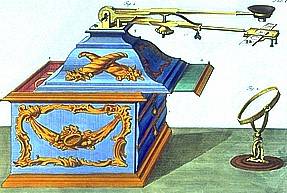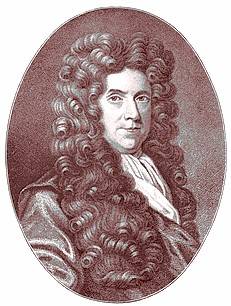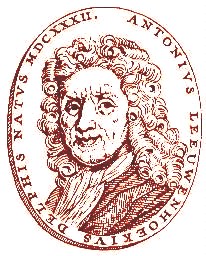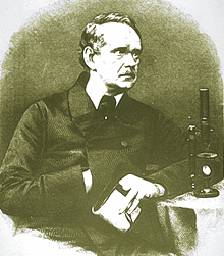At about the same time, another field of modern biology, cell biology, took its beginning with the invention of microscopy. The first intracellular structures were documented, staining became common and during the second half of the 19th century, a nuclear division was observed for the first time.
The origins of microscopy and physiology go back to the 17th century. Animated by HARVEY's dicovery of circulation, scientists went in search of something analogous in plants. The flow of sap was examined, the water balance of plants was studied and the insight that salts do have an outstanding role in the nutrition of plants gained acceptance. The microscope became a useful tool of research. P. BORELLI from the Dutch town Den Haag was one of its first users. When watching leaves, he saw nerves, spots, simple and star-shaped hairs. The Englishmen R. HOOKE (1635 - 1703) and N. GREW (1628 - 1711), the Italian M. MALPIGHI (1623 - 1694) and the Dutchman A. VAN LEEUWENHOEK (1630 - 1723) are regarded as the outstanding microscopers of the 17th century's last third. |
 |
They understood that the views seen in the microscope had to be judged and that a whole image had to be gained out of all the partial ones. They claimed that it was necessary to separate the important from the unimportant information and to bring the single observations in connection. The examinations had to be carried out with the aim to grasp the whole inner structure of the plant and to describe the results in a way that made them reproducible at any time. Skilful and well-considered preparation, careful combination of the different images and long practising were thought to be necessary to reach this aim. The stronger the magnification of a microscope, the smaller is the observed section, the smaller, too, is the depth of field and the higher are the demands on the ability to abstract. Since especially this last prerequisite was met only by few, the opinion that you could see anything you wanted through a microscope had spread far by the beginning of the 18th century. Through this it was that micoscropy stagnated for more than a century albeit having had such a promising start.
ROBERT HOOKE is regarded as the inventor of a useable two-lensed microscope. He observed sap-containing ducts with it and noticed walls in them, which he interpreted as valves. His main work "Micrographia" (1667) contains a number of observations made with the aid of a microscope; the most important of them are the depictions of the cork tissue. HOOKE recognized this fact and called the units he saw in this tissue cells. As a well-trained mathmatician and physicist he calculated their number to be 1000 per square inch. Besides his microscopical studies, he, too, worked on physiological processes and postulated that the snapping off of the leaf of Mimosa pudica was caused by the excretion ("exhaling") of a very delicate liquid. He explained that the stinging of nettles was due to the flow out of a caustic sap out of the bristles of the plant.
 N. GREW was a plant physiologist and anatomist. He assumed that the pollen
contained in the stamen was necessary for pollination. He was also the
first to describe tissues built from cells as being the basic elements
of vegetable structures. He attributed a special meaning to the pith of
the stem, made out fibres contained in the pith and distinguished three
different types: single fibres, scew-like fibres and sap-containing fibres
of the bast. He described the development of the wood and the arrangement
and shape of stomata; from him, too, stems the term parenchyma. He recognized that the single diciplines of botany had to be united and that the success of one branch of science is dependent on
that of the others. M. MALPIGHI (1628 - 1694)
was a professor at Bologna. His work "Anatomia plantarum"
was published in 1679. He worked, too, on the sap-containing fibres of the bark.
He analyzed the inner structure of roots and the germination process of
graminaceous plants. His depictions are more accurate than those of GREW,
but he was far more guided by his prejudices.
N. GREW was a plant physiologist and anatomist. He assumed that the pollen
contained in the stamen was necessary for pollination. He was also the
first to describe tissues built from cells as being the basic elements
of vegetable structures. He attributed a special meaning to the pith of
the stem, made out fibres contained in the pith and distinguished three
different types: single fibres, scew-like fibres and sap-containing fibres
of the bast. He described the development of the wood and the arrangement
and shape of stomata; from him, too, stems the term parenchyma. He recognized that the single diciplines of botany had to be united and that the success of one branch of science is dependent on
that of the others. M. MALPIGHI (1628 - 1694)
was a professor at Bologna. His work "Anatomia plantarum"
was published in 1679. He worked, too, on the sap-containing fibres of the bark.
He analyzed the inner structure of roots and the germination process of
graminaceous plants. His depictions are more accurate than those of GREW,
but he was far more guided by his prejudices.

A. van LEEUWENHOEK (1632 - 1723) from Delft analyzed numerous objects (infusories, red blood cells, germs). His observations were even more careful than those of GREW and MALPIGHI. When microscoping wood, he detected radial ducts consisting of cellular tissue and documented the organisation of cross-sections of the stem, dots in the secondary wood and crystals in cells.
The lenses, microscopes and the belonging items show the extraordinary technical and artistic skill with which the instruments were built. At the end of this period of research two types of vegetable tissue could be distinguished:
With the beginning of the 19th century, busy research activity began again. It headed especially into two directions:
In this analysis even the lower plants like algae, fungi, moss and fern that had formerly been neglected, were included. The research into reproductive organs was the decisive breakthrough in the understanding of the origins of and the relations between the great taxonomical groups. The developement from algae to angiosperms could suddenly be outlined in general terms.
Between 1800 and 1840, several micoscropers analyzed the anatomical structure of plants. With increasing practice in preparation and with the perfection of microscopes (increase in magnification, clearer visual fields, corrected colors) the drawings of microscopical pictures improved, too. Among the best-known micoscropers are C. F. MIRBEL (1776 - 1854; Paris), K. SPRENGEL (1766 - 1833; Halle), H. F. LINK (1776 - 1854; Rostock, Berlin), C. L. TREVIRANUS (1779 - 1864; Rostock, Breslau), J. J. BERNHARDI (1774 - 1850; Erfurt), P. MOLDENHAWER (1766 - 1827; Kiel), F. J. F. MEYEN and H. v. MOHL, the last three of which were already able to base their work on that of their predecessors.
Some exemplary results of the scientists of the first generation follow. MIRBEL put forward a theory of the structure of plant cells in 1801. SPRENGEL was the author of a textbook on the study of plants. TREVIRANUS discovered the intercellular space (1806) in the parenchyma and in 1821, the importance of the stomata. MOLDENHAWER introduced corn as a test object. He found out that the vessels are combined in sheafs and that they stand out against the parenchyma. He mazerated plant tissue by rotting in water and squashed the rests, thus gaining the structural elements (vascular tissues) for examination.
F. J. F. MEYEN (1804 - 1840) was a professor at Berlin and worked on the content of plant cells. In 1830, his textbook on phytotomy was published. He distinguished and described individual types of tissues, like mesenchyma, parenchyma, prosenchyma and pleurenchyma.
M. SCHLEIDEN (1804 - 1881) postulated in 1838 that all plant tissues are built from cells or derivatives of cells. He is regarded as the founder of the cell theory. The botanist C. W. v. NÄGELI (1817 - 1891) from Munich put up the still valid theory of cell formation. He classified the tissues in meristems and permanent tissues. R. BROWN (1773 - 1858; London) discovered the cell nucleus in 1840. Later on, SCHLEIDEN attributed it an outstanding role in the formation of cells. T. HARTIG (1805 - 1880; Braunschweig) was the first to discover the aleuron grains in seeds and A. PAYEN discovered the starch grains. By cooking them in a mixture of nitric acid and perchlorate, F. SCHULZE was able to isolate single cells out of wood in 1851 (mazeration procedure of SCHULZE). Since the 50th, the universities offered courses in microscopy. The quality of textbooks rose rapidly. M. SCHLEIDEN's work "Grundzüge der wissenschaftlichen Botanik" (Basic scientific botany) was pointing the way. |
 |
In the second half of the 19th century, the use of dyes for staining only poorly visible intracellular structures (nucleus and others) became increasingly common. This methological attempt allowed E. STRASBURGER in 1875 to observe nuclear division, the condensation of chromosomes and their distribution to the daughter cells.
|
|